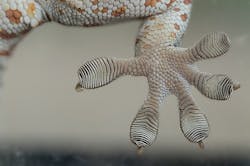The gecko's grip comes from these "walls" on its digits.
I had a gecko when I was a kid. I named him Slick and I fed him crickets. Once in a while he’d get loose and it would take several attempts to get him back in his tank. He was fond of scurrying up the living room wall and hanging out by the ceiling. I swear he’d mock us as we’d move the ladder to and fro. He died when I was in college. My mom sent me a letter announcing his death. I was devastated.That was nearly 30 years ago and I had long since forgotten about him until recently when I came across a study from researchers at the Georgia Institute of Technology. They have developed a method of making gecko-inspired adhesive materials. According to an article in Science Daily, it could lead to easy mass production of versatile gripping strips that can be used in manufacturing and on the consumer side.
"With the exception of things like Teflon, it will adhere to anything. This is a clear advantage in manufacturing because we don't have to prepare the gripper for specific surfaces we want to lift. Gecko-inspired adhesives can lift flat objects like boxes then turn around and lift curved objects like eggs and vegetables," said Michael Varenberg, the study's principal investigator and an assistant professor in Georgia Tech's George W. Woodruff School of Mechanical Engineering.
The gecko gets its grip via itty, bitty ridges or “walls” on its fingers (see photo). Researchers came up with a method to recreate the nanoscale walls but it involved molds and proved to be time consuming and expensive. And anyone who has ever baked a cake in an intricately detailed mold knows that getting all the cake out without it falling apart is near impossible.
The new method involves pouring the ingredients onto a smooth surface and then cutting into it to create the walls.
"There are many parameters to control: Viscosity and temperature of the liquid; timing, speed, and distance of withdrawing the blades. We needed enough plasticity of the setting polymer to the blades to stretch the walls up, and not so much rigidity that would lead the walls to rip up," Varenberg said in the Science Daily article.
While surfaces made via molding are usually the most precise, such perfection is unnecessary; the materials made with the new method did the job well and were also markedly robust.
Traci Purdum has a tattoo of two geckos chasing each other on her back. Researching this blog has inspired her to look into getting another real gecko in honor of Slick.About the Author
Traci Purdum
Editor-in-Chief
Traci Purdum, an award-winning business journalist with extensive experience covering manufacturing and management issues, is a graduate of the Kent State University School of Journalism and Mass Communication, Kent, Ohio, and an alumnus of the Wharton Seminar for Business Journalists, Wharton School of Business, University of Pennsylvania, Philadelphia.

